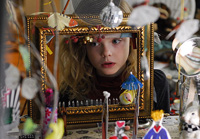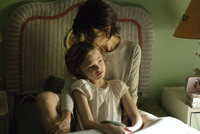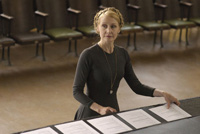“When I use a word,” Humpty Dumpty said in rather a scornful tone, “it means what I choose it to mean, neither more nor less.”
“The question is,” said Alice, “whether you CAN make words mean so many different things.”
—Lewis Carroll, Through the Looking Glass
Humpty Dumpty–esque word users can be seen (and heard) everywhere. After all, the English language is often bent, twisted, and manipulated to serve the users’ purposes. We see this in our use of labels: When someone doesn’t fit into cultural standards (boys who are effeminate, children who act out), he or she often gets slapped with easy—but not always accurate—labels.

This is just one of the areas in which the Sundance Film Festival–selected Phoebe in Wonderland uses the themes of Lewis Carroll’s classic tales to tell the story of a 9-year-old trying to make sense of herself and the real world around her. Phoebe Lichten (newcomer Elle Fanning, sister of Dakota) is the imaginative daughter of two intellectuals, Peter (Bill Pullman) and Hillary (Felicity Huffman). The latter is working on a book about Carroll’s works, and her love for that world has been passed to Phoebe. Her imaginary “Looking Glass Land” is the only place where Phoebe feels comfortable. Stuck in a harsh, rules-based world she doesn’t fit into, she longs to go to Alice’s Wonderland, where “things aren’t so fixed.”
Phoebe’s anxieties, questions, and internal struggles manifest in troubling ways. She mimics others, bursts into biting lines of mocking rhyme, and spits at people when threatened. She often feels an irresistible compulsion to blurt out inappropriate comments and repeat actions over and over. To make the school play, she decides she must complete a complicated series of clapping, turning, and stepping in squares. To her, this makes complete sense in a world where you must follow rules to get certain results.
When the school play turns out to be Alice in Wonderland, Phoebe finally finds a safe place. Here is her Wonderland: a place where she doesn’t need to follow rules or fit cultural standards. She can finally be imaginative, vulnerable, but confident Phoebe.

This movie isn’t all about Phoebe, though. In fact, one of this film’s biggest triumphs is that it depicts scenes between 9-year-olds and scenes between adults with the same respectful, truthful, realistic, and telling tone. We don’t just hear about Phoebe; we see and feel her life. While Phoebe tries to figure out her world, her parents try to figure out Phoebe.
Hillary is the main vessel through which the film explores the idea of words and labels applied to people who don’t fit into what one character calls the world’s “awful normals.” She angrily and stubbornly stands against labels placed on Phoebe by other kids, doctors, and school officials. When she was young, she says, she’d count telephone polls while riding in the car, believing that if she missed one, they would crash. Today, Hillary says, she’d get the label of obsessive compulsive. She tells a psychiatrist, “Your profession doesn’t let kids be kids.”
An immensely dense and intelligent film, Phoebe sets up meaningful parallels between its story and Alice in Wonderland while offering complementary storylines to emphasize and explore hefty material. For instance, alongside Hillary’s battle against labels is a deftly navigated subplot involving a little boy named Jamie who likes dolls and wants to play a queen in the play. When kids cruelly attack Jamie with homosexual slurs, the kids’ inspiring drama teacher corrects them in a stirring way—teaching them that “when you attach a word to someone, you better know what it means.”

This theme is brilliantly capped off by Hillary’s journey throughout the film. She learns that while misapplied labels are indeed damaging, properly used words—and the truths they represent—can bring understanding, relief, and hope. Perhaps most fulfilling is that this lesson, and the film’s other themes, are not delivered in a pandering, spoon-fed way. Captivating and stirring scenes of characters working out meaning and wading through tough issues—in realistically messy ways—earn the film the right to present its lessons.
Phoebe in Wonderland is one of those small gems of independent cinema that should not be missed by audiences craving more than entertainment (while still being entertaining, joyous, and downright fun at times). The acting is superb; Huffman is powerful in a wildly dynamic role, and Elle Fanning is already as good, or better, than big sister Dakota. The writing and story are near perfect (save for minor stereotyping of some characters and one easy plot shortcut), making the movie a wonderful escape into a mesmerizing, atmospheric world while still maintaining a grasp on real life. It balances the beauty of a child’s imagination with serious exploration of the human condition and depth of cultural analysis. In fact, a handful of unforgettable scenes lend hefty grist via dialogue to fuel much thought and conversation about identity, parenting, mental illness, and balancing the needs of individuals with the needs of the collective.
At the end of this exploration of identity, the caterpillar in Phoebe’s stage version of Alice in Wonderland asks Alice, “Who ARE you?” With much meaning packed into only an expression, Alice just smiles. She needs no words.
Talk About It
Discussion starters- Phoebe asks her parents, “Are you always supposed to feel hope?” What is your answer? How would you explain this to a child? Does the answer depend on one’s salvation? How can not feeling hope be a good thing?
- Jamie says to Phoebe, “If you want something, you have to pray or do something you hate and God will see you deserve it.” What was your impression of this scene? Do you ever slip into similar thinking about “deserving” your desires? How so?
- What are advantages and disadvantages of trying to fit individuals into the context of cultural norms? What does Miss Dodger’s term “awful norms” mean? What does identity mean? How does one find his or her true identity?
The Family Corner
For parents to considerPhoebe in Wonderland is rated PG-13 for thematic material and brief strong language. The language is limited to around 10 instances—including the F-word and the Lord’s name taken in vain. A derogatory word for homosexuals plays a central role; someone vandalizes property with it, and a teacher uses the event to teach the true meaning of the word and the application of labels. Thematic material circles around marital fights, the depiction of Phoebe’s OCD-like tendencies (including falling and washing her hands until they bleed), and adult discussions about medicating children with illness.
Photos © Copyright Silverwood Films
Copyright © 2009 Christianity Today. Click for reprint information.











